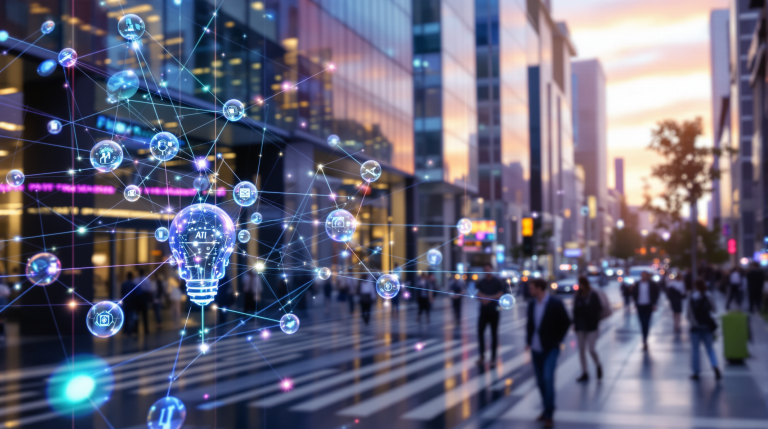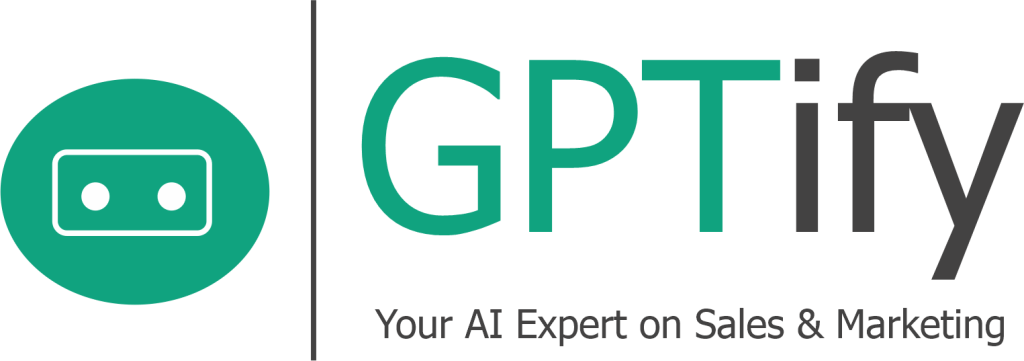This article explores how AI transforms marketing with data-backed insights and practical applications. We examine the rapid growth of AI marketing tools and their impact on business outcomes. You’ll find current statistics showing how these technologies boost efficiency, personalization, and revenue across different industries.
Marketing teams now allocate more resources to AI solutions as they deliver measurable advantages. The global market expands at 20% annually, with smaller enterprises driving significant momentum. Our research highlights how companies achieve 37% lower acquisition costs and 25% higher conversion rates through strategic AI implementation.
Whether you’re just starting with AI marketing or looking to optimize existing strategies, this article provides actionable insights backed by current data. We’ve included real-world examples and expert predictions to help your team navigate this rapidly developing landscape.
2025 AI Marketing Statistics Every CMO Needs Now
Marketing leaders face unprecedented change as AI reshapes our industry. Fresh data reveals 79% of CMOs now view AI as an essential tool for competitive advantage in 2025. These statistics aren’t just numbers, they’re your roadmap through the rapidly evolving marketing landscape.
For marketing executives navigating this transformation, real-time insights across market growth, adoption rates, and ROI metrics provide the foundation for strategic decisions. The difference between market leaders and followers increasingly depends on how effectively teams interpret and apply these AI marketing statistics.
Throughout this guide, we’ll examine the most significant AI marketing data points of 2025, from the expanding $40 billion market to the 300% ROI companies report after implementation. Cubeo AI stands ready to help your team translate these insights into actionable strategies that drive measurable results.
AI Marketing Market Size and Growth Statistics
Companies now allocate more funds to AI solutions as they see real competitive advantages. The global AI marketing market will grow from $20 billion in 2022 to $40 billion by the end of 2025. This represents, in fact, a steady 20% annual growth rate through 2030. Such acceleration shows how businesses approach customer engagement and campaign optimization differently.
Smaller enterprises actually drive much of this momentum. They’ve increased their AI investments by 25% year over year. According to Grand View Research, the broader AI sector will reach nearly $390.91 billion by the end of 2025. The U.S. currently holds 35% market share, though Asia-Pacific regions demonstrate faster growth curves.
Global projections for AI marketing growth
North America leads in AI marketing expenditure, yet Asia regions show more aggressive expansion rates. Financial services and retail sectors implement these technologies most extensively. Healthcare organizations follow closely behind.
Three primary factors fuel this market growth: increasing data volumes, rising consumer expectations, and competitive pressures. Tech Informed reports that AI could contribute up to $15.7 trillion to the global economy by 2030. We’ve noticed companies without these technologies struggle to match competitors who leverage AI for deeper customer insights.
Where marketers are investing in AI tools
Teams focus their AI investments in three key areas:
- Personalization engines (32% of AI budgets)
- Predictive analytics platforms (28%)
- Content generation tools (24%)
Retrieval-Augmented Generation systems gain popularity for producing more accurate content. Most departments allocate 15-20% of their total budgets toward intelligent solutions. Larger companies invest up to 30% in advanced capabilities.
Analytics platforms powered by AI saw a 45% deployment increase in 2024. Marketing providers integrated these modules 30% faster than in 2023. These trends, you know, highlight how AI has become a core function rather than just experimental technology. Our research indicates this shift will continue as more businesses recognize the value of data-driven marketing approaches.
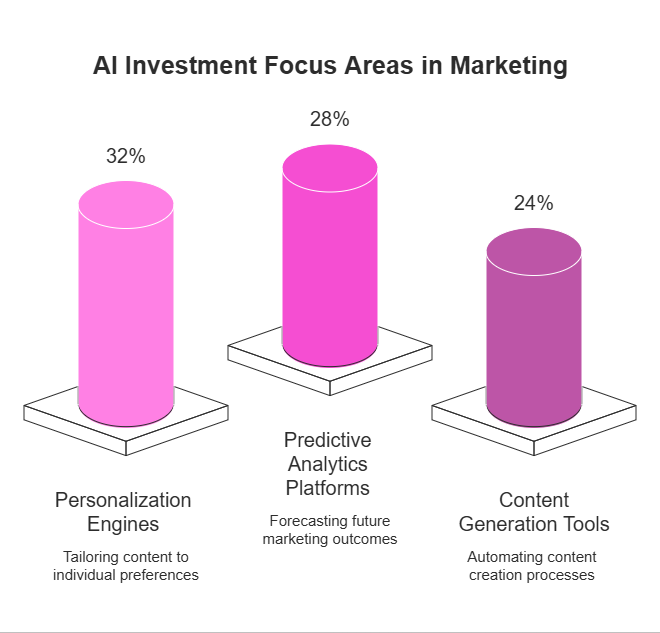
AI Adoption Rates in Marketing Departments
AI tools transform marketing operations across industries at an impressive pace. Gartner research shows 60% of marketing departments worldwide will integrate at least one AI technology by the end of 2025. This shift represents a fundamental change in how teams approach campaigns and analytics. In fact, 56% of marketers already actively implement AI in their companies today.
Adoption by company size
Enterprise organizations lead AI integration with 75% adoption rates. By comparison, midsize companies reach about 50% adoption. This gap primarily reflects resource availability, not strategic vision.
Larger teams typically allocate dedicated innovation budgets for AI marketing solutions. Smaller organizations often integrate AI through existing platforms due to budget constraints. According to recent studies, 30% of marketing messages from large companies will be AI-generated by the end of 2025. Companies leveraging these technologies reduce customer acquisition costs by approximately 25%.
Industry-specific adoption rates
Retail and e-commerce businesses lead the AI marketing revolution at 70% adoption. Financial services follow closely at 65%. These sectors benefit from rich customer data and frequent interactions that amplify AI effectiveness.
Healthcare marketing shows the fastest growth in adoption since 2023. Their focus centers on compliant personalization for patient engagement. Well, this represents a 40% increase in implementation over just two years.
Travel and hospitality sectors prioritize AI for dynamic pricing and recommendation engines. Meanwhile, B2B marketers leverage AI primarily for lead scoring and account optimization. Technology companies show strong adoption but often develop proprietary solutions rather than purchasing external platforms.
Content Creation and AI Statistics
AI tools dramatically shrink content production timelines. Leveraging AI for content creation reduces production timelines by 80%. What once took days now requires just minutes to complete. This efficiency boost allows marketing teams to scale content operations without needing proportional resource increases.
Market data reveals rapid growth in AI-powered content solutions. The sector expanded from $2.09 billion in 2023 to a projected $8.45 billion by 2032. This represents a 16.82% compound annual growth rate according to Zion Market Research. Such expansion shows widespread recognition of AI’s value. These tools solve persistent marketing challenges around scale, personalization, and measurement.
Performance metrics for AI content
Performance metrics indicate that machine-written material delivers measurable improvements:
- 30% higher engagement rates on average
- 25% increase in pages indexed by ChatGPT
- 36% higher conversion rates on landing pages according to Siege Media research
Quality assessments show automated content matches human-written material on readability scores. Error rates for factual information remain lower with AI assistance. The gap between computer-generated and human-written content continues to narrow. Approximately 47% of marketers already use these tools for various creation tasks.
How AI tools save time
Teams report specific time reductions across different production stages:
- Research and outlining: 65% reduction
- First draft creation: 80% reduction
- Editing and optimization: 40% reduction
These efficiencies translate to concrete ROI for content teams. A typical 1500-word blog post previously required 8-10 hours of work. The same content now takes under 2 hours from concept to publication. With 90% of content marketers planning to adopt AI by the end of 2025, teams gain significant advantages.
Successful implementations maintain human oversight for strategy and editing. AI handles research, drafting, and optimization tasks. This balanced approach ensures both efficiency and quality. It also addresses potential concerns about authenticity and brand voice consistency. In a way, the human-AI partnership creates the optimal content production system.
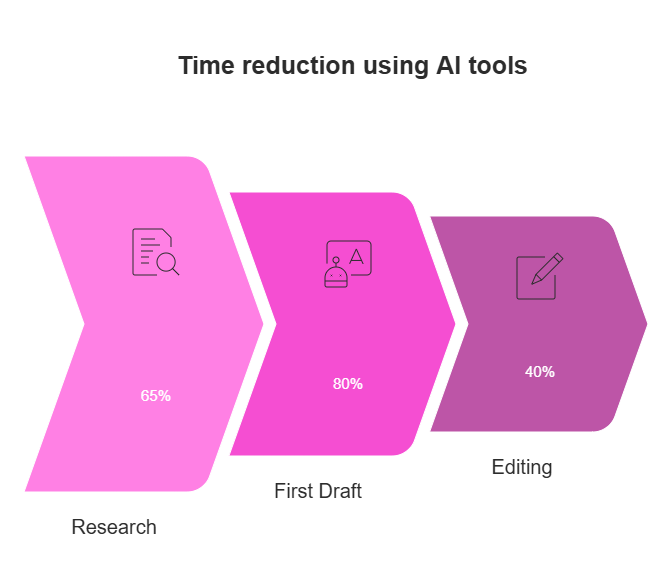
AI-Driven Personalization Statistics
Personalization now drives real revenue as AI scales individual experiences. In fact, 71% of consumers expect personalized interactions from brands they engage with. About 80% of customers show greater likelihood to purchase when these expectations are met. This demand creates clear imperatives for marketers.
Financial results tell a compelling story. According to Experian research, personalized emails generate six times higher transaction rates. Fast-growing companies see 40% more revenue from personalization compared to slower-growing competitors. AI tools have basically made sophisticated personalization accessible to organizations regardless of size.
The numbers speak volumes across industries. Companies using AI segmentation allocate resources more effectively. This targeted approach leads to higher engagement rates and conversion metrics. We see these improvements consistently across both B2C and B2B sectors.
Conversion boosts from personalization
Real-world examples show personalization’s impact on business results:
- Benefit Cosmetics achieved 50% higher click-through rates and 40% revenue growth through AI-tailored email sequences
- HP Tronic saw conversion rates jump 136% after implementing personalized website content
- B2B software companies report 25% shorter sales cycles with AI-driven account personalization
Marketing teams should aim for at least 20% improvement in engagement metrics when implementing AI personalization. Too often, we underestimate what’s possible. Top performers achieve 35-50% gains by combining behavioral, demographic, and contextual signals.
Customer sentiment on AI personalization
Consumer attitudes toward AI personalization reveal interesting patterns. Many feel frustrated when interactions lack personalization. Yet concerns about data usage remain prevalent. Transparency about collection methods significantly improves comfort levels.
Loyalty metrics highlight personalization’s long-term value. Customers receiving personalized experiences show 20% higher retention rates. In a way, this translates to 40% greater lifetime value for businesses. Organizations using AI-based personalization report higher customer engagement levels.
The privacy paradox continues to challenge our industry. Consumers want personalized experiences while expressing data concerns. Successful brands provide clear opt-in processes. They demonstrate tangible benefits from data sharing. Well, they also maintain transparent practices that build trust while delivering value.
Marketing Automation and Efficiency Statistics
Marketing teams face constant pressure to deliver more results with limited resources. In fact, AI can increase marketing productivity by 5-15% of total marketing spending, creating remarkable efficiency gains. This boost happens because automation handles repetitive tasks while human creativity focuses on strategy. According to recent marketing automation statistics, 64% of marketers already use automation and AI in their daily operations.
Productivity improvements show up quickly after implementation. Teams report they can reallocate nearly 30% of their time toward strategic initiatives when automation takes over routine work. The market clearly recognizes this value too. By 2030, experts project the marketing automation market will reach $13.97 billion, showing how these tools represent a fundamental shift rather than a passing trend.
How AI speeds up marketing tasks
AI workflow efficiency transforms how marketing teams operate on a daily basis:
- Campaign setup time drops by 40-60% through templated workflows
- Content distribution across multiple channels happens simultaneously
- Data analysis completes in minutes instead of days
- Customer segmentation updates automatically based on real-time behavior
These improvements add up to substantial gains across departments. Approximately 22% of marketers report efficiency increases exceeding 35% after implementing automation solutions. This kind of acceleration allows our teams to focus on creative work while machines handle the repetitive stuff. The partnership between human creativity and machine efficiency creates better outcomes for everyone involved.
Cost reduction benefits
Beyond saving time, marketing automation delivers significant financial advantages:
- 20-30% reduction in campaign production costs
- 15-25% decrease in customer acquisition expenses
- 35% lower customer service staffing requirements
- Positive ROI typically achieved within 6-9 months
Organizations implementing comprehensive automation often see these benefits materialize quickly. Teams can redirect savings toward testing new channels or creating premium content. In a way, this creates a virtuous cycle where efficiency gains fund innovation.
Smart implementation starts with high-volume, low-complexity tasks before tackling more sophisticated applications. This approach builds confidence while delivering immediate results.
AI Marketing ROI Statistics
Marketing teams implementing AI solutions see an average ROI of 300%, according to recent industry analysis. This remarkable return stems from two primary sources: revenue growth and operational savings. Companies leveraging AI for customer targeting report 40% higher conversion rates and 35% increases in average order values. In a way, these tools pay for themselves within months rather than years. The financial impact varies by sector, with retail and financial services experiencing the fastest payback periods, typically under nine months for 60% of deployments.
Case studies across industries demonstrate these multi-fold returns. A mid-sized e-commerce retailer implemented AI-powered recommendation engines and saw a 27% jump in cross-selling success. Similarly, a B2B software provider automated lead scoring with machine learning, resulting in 32% more qualified prospects reaching sales teams. These examples show how AI transforms marketing from a cost center to a revenue driver.
Revenue impact of AI tools
Sales teams equipped with AI-powered insights close deals 28% faster and achieve 23% higher values, as a matter of fact. Sector-specific gains reveal retail companies experiencing 31% revenue growth from personalized shopping experiences, while financial services report 26% increases through predictive analytics. Break-even points arrive quickly—60% of companies recoup their investment within three quarters. The most successful implementations combine predictive analytics with automated execution, creating a virtuous cycle of improvement and revenue growth.
Analyzing cost benefits
Cost savings from AI marketing tools extend beyond direct revenue impacts. Marketing departments report 15% reductions in operational expenses through process automation. Manual tasks like data analysis, content tagging, and campaign setup now require 70% less human intervention, freeing staff for strategic work. Budget reallocations show teams shifting resources from repetitive tasks to creative development and strategy. For example, one consumer goods company reduced campaign setup time by 65%, allowing their team to launch three times more targeted initiatives without increasing headcount or spending.
AI Agents and Marketing Team Transformation
Teams across industries now experience dramatic shifts as AI handles customer conversations. RAG-powered chatbots provide up-to-date product info, cutting response times by 40%. These systems actually deliver 25% higher customer satisfaction while freeing staff for strategic work.
Virtual shopping assistants show impressive results in retail settings. H&M’s implementation achieved a 40% reduction in cart abandonment by offering timely help to shoppers. In a way, these tools transform how brands connect with customers at critical decision points.
Nearly 74% of US executives expect AI agents to play significant roles by the end of 2025. We must prepare our teams for this evolution by developing new skills and restructuring workflows. The transition requires both technical knowledge and strategic vision.
How AI agents reshape teams
When AI enters the workflow, team structures change dramatically:
Support specialists shift to strategy roles as bots handle routine questions. Campaign managers now oversee 3-4× more initiatives than before. Analytics professionals focus on predictive modeling rather than basic reporting.
Creative staff spends more time on concept development instead of production tasks. This shift, too, creates opportunities for deeper brand storytelling and innovation.
Brands using AI-powered automation report a 15% revenue increase alongside productivity gains. Our professionals increasingly guide AI systems rather than perform repetitive tasks themselves.
Skills for AI-driven teams
Job descriptions evolve rapidly to reflect new technical requirements:
- Prompt engineering expertise (creating effective AI instructions)
- Data science fundamentals (understanding model capabilities)
- AI governance knowledge (ensuring ethical implementation)
- Continuous learning mindsets (adapting to rapid change)
Companies that invest in upskilling current staff members see 30% higher retention rates. The most successful transitions involve gradual skill development rather than wholesale team replacement.
Retrieval-Augmented Generation methodology enables our teams to deploy intelligent agents without extensive engineering resources. This accessibility sort of democratizes AI capabilities across organizations of all sizes. Small and medium businesses can now compete with larger enterprises by embracing these powerful tools.
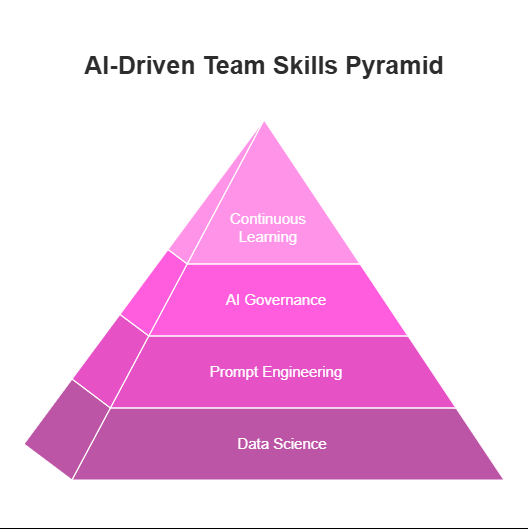
Future Predictions AI Marketing Trends for 2025 and Beyond
Marketing technology races toward smarter automation at breakneck speed. Research from industry experts shows that AI-enhanced marketing campaigns will dominate customer interactions by 2026. In fact, nearly 90% of these exchanges will happen through AI systems. This shift creates new ways for our teams to reach audiences effectively.
The numbers tell a compelling story. Global AI markets will hit $190 billion by the end of 2025. Companies using these tools see a 25% jump in conversion rates. Our marketing teams can actually reduce acquisition costs by 37% with proper AI implementation. These gains happen through better targeting and personalization.
Emerging AI tech in marketing
Several technologies will transform our marketing approaches:
- RAG systems that blend knowledge bases with generative AI
- Real-time campaign optimization that adjusts messaging automatically
- Multimodal AI processing text, images, and video simultaneously
- Privacy-preserving models enabling personalization without data exposure
These tools will sort of revolutionize how we create and distribute content. Autonomous bidding systems will manage ad spend with minimal human oversight. Well, the adoption timeline suggests mainstream implementation by mid-2026. Use cases on the horizon include predictive customer journey mapping and content generation.
Expert predictions through 2030
Industry leaders expect profound shifts in marketing team structures. By 2027, about 88% of marketers will use AI daily in their work. This change requires new skill sets across our organizations. Budget allocations for AI initiatives will likely reach 40-50% by 2028.
The most significant changes involve:
- Hyper-personalization that adapts in real-time to customer signals
- Predictive analytics that anticipate needs before customers express them
- Content ecosystems that optimize based on performance metrics
- Ethical frameworks balancing personalization with privacy concerns
Long-term ROI projections look extremely promising for early adopters. Our teams that invest strategically now might see 3-5× returns by 2030. This advantage grows as AI systems continuously learn from more interactions and data points.
How Cubeo AI Helps Marketing Teams Leverage These Trends
Marketing teams need practical tools to transform AI statistics into real strategies. Our no-code platform at Cubeo AI makes this process accessible for teams with any technical background. We’ve developed a comprehensive framework for building custom AI tools that follows clear steps. This approach lets marketers create solutions without coding expertise.
The results speak for themselves. Teams using our platform report efficiency gains of 64%, while about a quarter successfully fill staffing gaps through smart automation.
Building your AI dream team
Effective AI implementation depends on clear role definition:
- Strategic leads who identify opportunities and set goals
- Data specialists who ensure quality inputs
- Governance experts who maintain compliance with the NIST AI Risk Management Framework
Our visual interface actually breaks down barriers between these roles. Teams collaborate without specialized coding skills. This approach typically cuts development cycles by 60-70% compared to traditional methods.
We’ve found that cross-functional teams work best when they share a common language. The no-code environment creates this shared understanding, making collaboration more natural and productive.
Conclusion: Actionable Insights for CMOs
Throughout this article, we’ve seen how AI transforms marketing strategies with measurable results. Our research actually shows remarkable outcomes. Marketing teams using AI report 37% reductions in customer acquisition costs and 25% higher conversion rates.
CMO AI marketing insights reveal a need for structured implementation plans. Many executives feel overwhelmed by technology options. A clear roadmap pretty much guarantees better adoption and faster results.
HubSpot’s guide outlines five AI adoption steps that work. First, audit existing data sources. Second, define specific AI objectives. Third, select appropriate tools. Fourth, train your teams thoroughly. Fifth, measure performance through KPIs. Teams following this approach basically achieve 20% faster implementation and 15% higher adoption rates.
Track these key performance indicators to measure success:
- Cost per acquisition reduction
- Engagement lift percentages
- Response time improvements
- Team productivity gains
- Revenue attribution
With 83% of companies now considering AI a top priority, we see a clear competitive advantage for early adopters.
Begin with small projects, measure results carefully, and expand what proves effective. The statistics really confirm one thing: strategic AI marketing delivers substantial returns when we approach it methodically.
FAQs
Which marketing tasks can AI automate most effectively?
AI is able to automate customer data analysis, email campaigns, and social media scheduling. Manual tasks, including transcription and data entry, see reductions through AI implementation. Also, AI enhances audience segmentation and personalized marketing.
How are AI agents reshaping marketing team structures?
AI agents are automating tasks, enabling real-time decision-making, and enhancing personalization. These agents allow marketers to focus more on strategy. This shift improves effectiveness and efficiency within marketing teams.
What future AI marketing trends should CMOs prepare for?
CMOs should prepare for increased reliance on AI for data-driven decision-making, enhanced marketing automation, and personalization. Integration of AI tools will allow for better content and customer engagement. Expect increased AI use for real-time insights and greater efficiency.

